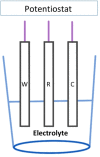The Combination of Electrochemistry and Microfluidic Technology in Drug Metabolism Studies
- PMID: 36166688
- PMCID: PMC9716038
- DOI: 10.1002/open.202200100
The Combination of Electrochemistry and Microfluidic Technology in Drug Metabolism Studies
Abstract
Drugs are metabolized within the liver (pH 7.4) by phase I and phase II metabolism. During the process, reactive metabolites can be formed that react covalently with biomolecules and induce toxicity. Identifying and detecting reactive metabolites is an important part of drug development. Preclinical and clinical investigations are conducted to assess the toxicity and safety of a new drug candidate. Electrochemistry coupled to mass spectrometry is an ideal complementary technique to the current preclinical studies, a pure instrumental approach without any purification steps and tedious protocols. The combination of microfluidics with electrochemistry towards the mimicry of drug metabolism offers portability, low volume of reagents and faster reaction times. This review explores the development of microfluidic electrochemical cells for mimicking drug metabolism.
Keywords: cancer. drug metabolism. electrochemistry; microfluidics; reactive Metabolites.
© 2022 The Authors. Published by Wiley-VCH GmbH.
Conflict of interest statement
The authors declare no conflict of interest.
Figures







Similar articles
-
Microfluidic Electrochemistry Meets Trapped Ion Mobility Spectrometry and High-Resolution Mass Spectrometry-In Situ Generation, Separation, and Detection of Isomeric Conjugates of Paracetamol and Ethoxyquin.Anal Chem. 2021 Sep 21;93(37):12740-12747. doi: 10.1021/acs.analchem.1c02791. Epub 2021 Sep 8. Anal Chem. 2021. PMID: 34495637
-
A Disposable Microfluidic Device with a Screen Printed Electrode for Mimicking Phase II Metabolism.Sensors (Basel). 2016 Sep 2;16(9):1418. doi: 10.3390/s16091418. Sensors (Basel). 2016. PMID: 27598162 Free PMC article.
-
Electrochemical generation of selegiline metabolites coupled to mass spectrometry.J Chromatogr A. 2015 Apr 10;1389:96-103. doi: 10.1016/j.chroma.2015.02.049. Epub 2015 Feb 21. J Chromatogr A. 2015. PMID: 25746755
-
Electrochemistry in the mimicry of oxidative drug metabolism by cytochrome P450s.Curr Drug Metab. 2011 May;12(4):359-71. doi: 10.2174/138920011795202929. Curr Drug Metab. 2011. PMID: 21395527 Review.
-
Exploiting plug-and-play electrochemistry for drug discovery.Future Med Chem. 2016 Apr;8(5):567-77. doi: 10.4155/fmc.16.8. Epub 2016 Apr 15. Future Med Chem. 2016. PMID: 27079543 Review.
Cited by
-
[Bibliometric analysis of exosomes in the biomarker research field].Se Pu. 2025 May;43(5):498-507. doi: 10.3724/SP.J.1123.2025.01025. Se Pu. 2025. PMID: 40331613 Free PMC article. Review. Chinese.
-
Structural Characterization and Electrochemical Studies of Selected Alkaloid N-Oxides.Molecules. 2024 Jun 7;29(12):2721. doi: 10.3390/molecules29122721. Molecules. 2024. PMID: 38930787 Free PMC article.
References
-
- August J. T., Murad F., Anders M. W., Coyle J. T., Li A., Drug-Drug Interactions: Scientific and Regulatory Perspectives, Academic press, USA, 1997, 104.
-
- Greger R., Windhorst U., Comprehensive Human Physiology from Cellular Mechanisms to Integration, Springer, Germany, 1996, 151.
-
- Edwards L. S., Coyne I., A survival Guide to Children's Nursing, Elsevier, UK, 2013, 371.
-
- Xu C. J., Li C. Y. T., Kong A. N. T., Arch. Pharm. 2005, 28, 249–268. - PubMed
Publication types
MeSH terms
LinkOut - more resources
Full Text Sources

